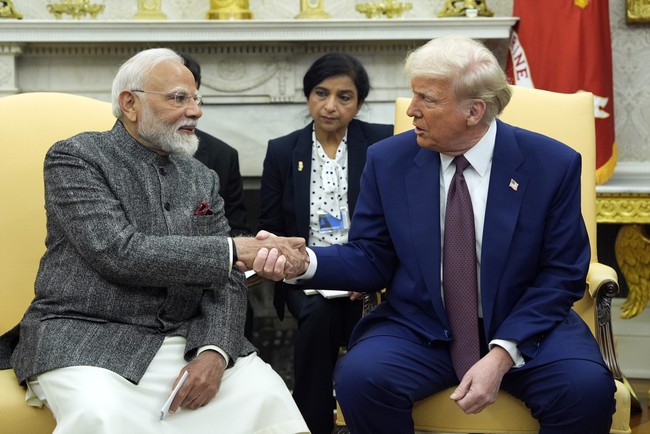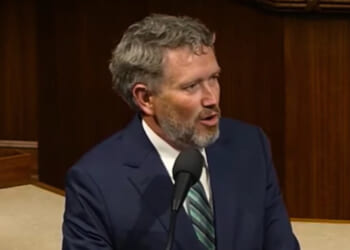
Donald Trump promised to bring peace to global conflicts, and here we are. On Saturday morning at 7:55 a.m. ET, Trump posted this on Truth Social:
After a long night of talks mediated by the United States, I am pleased to announce that India and Pakistan have agreed to a FULL AND IMMEDIATE CEASEFIRE. Congratulations to both Countries on using Common Sense and Great Intelligence. Thank you for your attention to this matter!
This was a swift and unexpected end, or at least pause, to a conflict that had threatened to spiral into nuclear war. On Friday, White House Press Secretary Karoline Leavitt stated: “The President has expressed he wants to see this de-escalate as quickly as possible. He understands these are two countries that have been at odds with one another for decades, long before President Trump was here in the Oval Office.”
Indeed they have. India and Pakistan have been at odds ever since there has been a Pakistan, and in some ways, even before that. As “The History of Jihad” explains, after World War II, as the sun was setting on the British Empire, India was partitioned into a majority-Hindu area, known as India, and two majority-Muslim areas, known as East Pakistan (later Bangladesh) and West Pakistan. The name Pakistan was an amalgamation of the names of the regions that made it up: Punjab, Afghania, Kashmir, Sindh, and Baluchistan. “Pak,” however, also means “pure” in Urdu and Persian, and for many Muslims, Pakistan, a land created specifically for Muslims, was to be the land of the pure expression of the faith.
The seeds of the partition were planted with the first jihad invasion of India in the eighth century, which was a manifestation of Islam’s hatred of and contempt for the infidels. Centuries of bloody oppression led to significant levels of resentment of Muslims among the Hindu population of India. In the aftermath of World War I, the Khilafat (caliphate) movement among Muslims in India protested against the secular Turks’ marginalization, and subsequent abolition, of the Islamic caliphate in 1924. In doing so, it promoted the idea that the Muslims of the world should be united in a single state, although this had not actually been the case at any point in history except, arguably, in the age of the “Rightly-Guided Caliphs” before the Sunni/Shi’a split became formalized, but the new propagation of this idea undermined prospects for Indian unity.
Although Pakistan’s founding leader Muhammad Ali Jinnah was not a doctrinaire Muslim and did not found Pakistan as a state ruled by Islamic law, the proponents of jihad and Sharia backed the partition because it was unacceptable to them for Muslims to live under infidel rule. The partition itself was acrimonious, with over a million people killed and fifteen million made refugees. Almost immediately, the new state of Pakistan began waging jihad against India, in September 1947 arming militias fighting against Indian rule in the disputed state of Jammu and Kashmir. Arif Jamal, a historian of the jihad in Kashmir, notes that “Jinnah had signed a stand-still agreement with the Maharaja [ruler] of Jammu and Kashmir, and jihad by tribesmen violated that agreement. The Maharaja then invited Indian troops to defend the state, which led to the first war between India and Pakistan and the division of Kashmir by the end of 1948.”
Related: Trump Calls Kashmir Terror Attack ‘Deeply Disturbing’ as Sickening Details Emerge
A historian of Kashmir, Talat Bhat, notes that the drive for Kashmiri independence from India grew progressively more jihadist in character toward the end of the twentieth century, thanks to Pakistani government interference: “Kashmir’s independent movement began in 1948 and kept gaining strength in Indian-occupied areas until 1985, a year after the hanging of the separatist leader Maqbool Bhat in 1984. His Jammu and Kashmir Liberation Front (JKLF) party declared war on India in 1988, which also led to a popular independence movement. But in 1991, Pakistan’s ISI created Hizbul Mujadeen (HM), an Islamist militant organization, to counter secular JKLF. Between 1991 and 1993, most JKLF commanders were either killed or jailed by HM or Indian troops. In 1994, JKLF declared unilateral ceasefire but Islamabad sent more Islamists, who had fought the war in Afghanistan, to Kashmir.”
Pakistan and India have remained in an ongoing state of war since the partition, due to Pakistan’s jihadi intransigence and fanaticism, with outbreaks of actual violence in 1947, 1965, 1971, and 1999. It was yet another Pakistan-backed jihad attack in Kashmir on April 22, 2025 that provoked the current conflict between the two countries.
Given the ongoing jihadist fanaticism in Pakistan, the Trump-brokered ceasefire is not likely to last too terribly long. It does, however, push back the specter of nuclear war from the world once again, at least for the time being. And the fact that there is a ceasefire at all is another remarkable success of Trump’s foreign policy approach.
Even if Trump cured cancer and ended war forever, the establishment media would still be portraying him as evil incarnate. That’s why you need to become a VIP member today. You’ll get our exclusive content, VIP-only articles, podcasts, and no ads. Use code FIGHT for 60% off. Now is the time to stand for the truth!

















